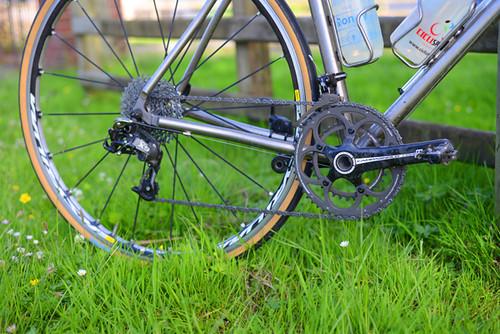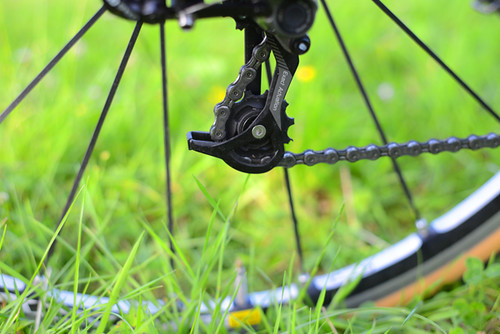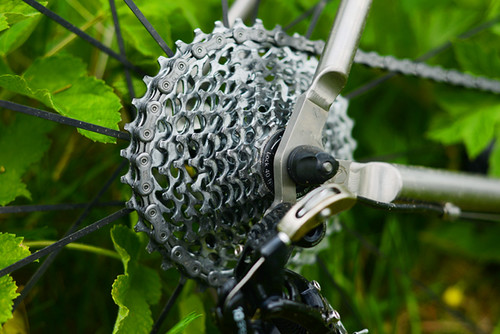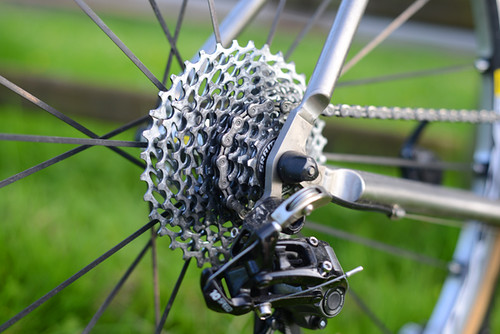
(Photo: Eying the intimidating exit on Bonnie's Roof Direct (5.9).)After two days of great climbing in Colorado, I was feeling in shape for the three-day Labor Day weekend. Gail invited us to stay at her house in Gardiner. Of course Gail and I couldn't just ignore our spouses and disappear for three days. It worked out that we climbed in the morning on each of the three days, leaving the afternoons free for other activities. This worked out for both of our families and it was plenty of climbing for me. It meant that, putting the climbing days in Colorado and the Gunks together, I got to climb on five out of the nine days from August 26 to September 3. I've never had a run of climbing like that before.I wanted to hit it pretty hard in the Gunks. I was climbing well in Colorado and I thought there must be a 5.10 I could slay over the Gunks weekend. For some reason I had my heart set on Directississima/Doubleissima (5.10b). I knew in advance that this wasn't the easiest 5.10 out there. Maryana had told me she thought it was really hard. Dana had advised me that it was one to save for later. It appeared super-sustained and steep. But ever since I'd done the neighboring Ridicullissima (5.10d) on top rope and really enjoyed it I had been dying to come back and try Doubleissima. I just love that steep face. It calls to me. And I thought the pro would be good, so why not try it? I told Gail I wanted to go for it on Saturday.Gail suggested I try Bonnie's Direct as a warm-up, which seemed like a wonderful idea. Bonnie's is such a great classic line. The regular route, with its easyish 5.9 (historically 5.8+) first pitch and the exciting, 5.7 traversing second pitch, is one of my favorites. The first pitch was one of my first 5.9 leads in , and I believe I followed it once (and then led the second pitch) in , but I hadn't been back in two years, and I'd never done the direct finish.

(Photo: Leading the regular pitch two (5.7) of Bonnie's Roof back in .)On Saturday the first pitch was a joy. That opening roof is so satisfying. The hardest move for me is the little stretch to get to just underneath the overhang. Once you are there, you can throw a big blue # 3 Camalot into the space behind the point of the roof and go. The holds are awesome.Soon enough it was time to confront the second pitch: the direct finish. People seem to think this variation is really hard. Dick Williams gives it a 5.9 rating is his book. Swain says 5.9+, and I have heard others suggest it is really a 5.10. It certainly looks challenging from below. A thin vertical crack appears to be the only means with which to surmount the big overhang.But looks can be deceiving. It turns out to be pretty easy. There is a bomber edge out there. I don't want to spell it all out, but look around, people! I can see how it would be really hard using only the crack to jam your way out. But using my patented secret edge, the initial overhang is pretty straightforward, and then the exit to the top, left past another two-tiered roof, is all jugs. I think the direct finish is no harder than 5.9. It is exposed and thrilling but a little too short. Having finished both ways, I think I prefer the regular 5.7 exit.After Bonnie's Direct went down so easily I was pumped up for Doubleissima. This was going to be fun. Or so I thought.Doubleissima kicked my ass.

(Photo: Gail almost through the crux bulge on Doubleissima (5.10b), after I bailed off to the right. Unlike me, she made it look easy.)
The first pitch was not a problem. There are two crack systems next to each other; both are 5.8. Gail said the one on the right has better pro, so I did that one. She also told me that most people combine this short pitch right into the next one, so I decided I would too. I got through the pitch without using any of my favorite pieces, and figured I might as well continue without stopping.
The real business begins early in the second pitch. The crux bulge comes pretty quickly off the ledge, and it is hard! The going is steep, and then a long reach is needed to get through the bulge to a good hold. There are intermediate holds but they aren't that great.
I wanted to protect this section well, so I placed one cam, and then another. Eventually I had three good cams in the crux. I wore myself out placing all the gear and fiddling with it. But the gear wasn't my only problem. I also didn't want to make the big move so I tried a number of different ways to get my feet up. Through all of this experimentation I did a mixture of holding on, then eventually hanging and falling. I don't even know how many times I went up and retreated or dropped down.
Finally I just went for the move and I made it. I was over the bulge at last, but the damage was done. My arms were on fire and with each step I wanted to place a piece because I was afraid I would peel off. The going was still so steep. I had expected it would ease off a bit more after the bulge. I was losing control. I had to admit I was defeated. At this point I desperately wanted to be off of that wall. I didn't even want to try the roof that is the second crux.
I saw a good horizontal handrail going all the way to the gully to the right and decided to bail. I headed directly across the gully to the High E rap bolts. We ended up doing less than half the second pitch. Gail, following the pitch, sailed right through the one hard part that I'd tackled.
I left Doubleissima feeling destroyed. I was totally drained afterwards. We tried to do another climb and I barely got through it. I was done for the day. I felt so wrecked I worried I might not be able to do much climbing for the rest of the weekend.
But after an afternoon at the pool and a good night's rest Gail and I had a great morning in the Nears on Sunday. (More on that later.) And on the holiday Monday, back in the Trapps, I felt like I was really climbing well again. (More on that later.) Gail suggested that we finish our weekend of climbing together with Retribution (5.10b).

(Photo: Gail cruising the crux moves on Retribution (5.10b).)
Now, just about everyone has toproped Retribution (and its neighbor Nosedive (5.10b)) at one time or another. It sits right there tempting you at the beginning of the cliff near the parking lot, looming directly above the carriage road. And it is so easy to set it up by running up Bunny (5.4) to the left.
For the longest time I avoided toproping or following Retribution because I was saving it for the onsight. I wanted to walk up and lead it without any rehearsal. In there were several occasions on which I nearly gave it a whirl.
But I never did, and then I broke my ankle and spent a year recovering my lead head. Along the way I gave up all that baloney about saving climbs for the onsight and ended up toproping it once with Vass, and then following both Adrian and Maryana up Retribution when they led it on separate occasions.
So when Gail suggested that I lead it on Monday I was already familiar with the demands of the climb. And I knew that even though it, like Doubleissima, is rated 5.10b, Retribution is a much much easier climb than Doubleissima. The crux is short, just moving past the little roof. The rest of the way is 5.8 or 5.9. My only real worry was that I'd get through the crux but be exhausted and then fall before getting good gear in the shallow corner directly above the roof. Or that in a spate of nervousness I'd blow the crux and never make it over the roof.
I needn't have worried. It went fine. I felt really good. My footwork was solid and the fingerlocks in the crux felt huge. I scampered past the roof and up the little corner, alarming Gail a little with how long I continued before placing gear above the roof.
This was my first 5.10b trad lead. Though I was happy about it I didn't feel like it erased my fiasco on Doubleissima, from which I stumbled off feeling like I wasn't even close to ready to lead 5.10b. But with the rosy glow of hindsight I'm starting to feel like trying Doubleissima again. Even though I failed, I was never unsafe. If I can place two of the three pieces I had last time, but put them in quickly, and then go for the move through the bulge right away-- no hesitation-- then maybe I could get it. Just maybe.






 You can see a little patch of blue coming through the clouds, promises of things to come. This is the Worthington Glacier, taken a few minutes before 9 o'clock. I don't know its dimensions. Lets just say that it's big!
You can see a little patch of blue coming through the clouds, promises of things to come. This is the Worthington Glacier, taken a few minutes before 9 o'clock. I don't know its dimensions. Lets just say that it's big!

 The trail up to the top of glacier (a mile long with a 1200 foot elevation gain) was “officially” closed and warning signs were posted regarding the instability of the glacier and the area surrounding it. However, I saw several people scrambling over the rocks and hiking out to it, though they only went to the face of the glacier, not to the top. Two people can be seen in this photo, above and to the right of the trees. (Double-click on the photo to see a larger version.) If you are interested, in July .. several guys hiked to the top of the glacier. They have posted an entry with lots of neat photos at Natural Born Hikers.
The trail up to the top of glacier (a mile long with a 1200 foot elevation gain) was “officially” closed and warning signs were posted regarding the instability of the glacier and the area surrounding it. However, I saw several people scrambling over the rocks and hiking out to it, though they only went to the face of the glacier, not to the top. Two people can be seen in this photo, above and to the right of the trees. (Double-click on the photo to see a larger version.) If you are interested, in July .. several guys hiked to the top of the glacier. They have posted an entry with lots of neat photos at Natural Born Hikers. If you look real close, you can see that two people are standing at the bottom edge of the glacier, in the center of the picture. Really.
If you look real close, you can see that two people are standing at the bottom edge of the glacier, in the center of the picture. Really. Cropped and enlarged version of the previous photograph. Can you see them now?
Cropped and enlarged version of the previous photograph. Can you see them now? To the north and west, the skies were trying to clear. The little lake was formed when the glacier retreated. The drive back to Glennallen in the afternoon more than made up for the dreariness of the morning. Although clouds filled the sky, there was also plenty of sunshine!
To the north and west, the skies were trying to clear. The little lake was formed when the glacier retreated. The drive back to Glennallen in the afternoon more than made up for the dreariness of the morning. Although clouds filled the sky, there was also plenty of sunshine!


 The mountains are part of the enormous Wrangell-St. Elias National Park and Preserve.
The mountains are part of the enormous Wrangell-St. Elias National Park and Preserve. Homer is at the end of the Kenai Peninsula in the lower left. Haines is in the lower right corner, a driving distance of approximately 900 miles. The route from Valdez to Haines more or less follows the perimeter of the Wrangell-St. Elias National Park. Skagway is only 15 miles from Haines via ferry but is 300 miles via the highway! The yellow-highlighted routes are the roads that I've traveled thus far. (On the day this post was scheduled – August 24th - I was in Haines.)
Homer is at the end of the Kenai Peninsula in the lower left. Haines is in the lower right corner, a driving distance of approximately 900 miles. The route from Valdez to Haines more or less follows the perimeter of the Wrangell-St. Elias National Park. Skagway is only 15 miles from Haines via ferry but is 300 miles via the highway! The yellow-highlighted routes are the roads that I've traveled thus far. (On the day this post was scheduled – August 24th - I was in Haines.)





 And tonight, we're having fresh local shrimp, squash and onions (or maybe a squash casserole), creamed corn and tomatoes. Lazy Girl peach cobbler for dessert. I love summer.
And tonight, we're having fresh local shrimp, squash and onions (or maybe a squash casserole), creamed corn and tomatoes. Lazy Girl peach cobbler for dessert. I love summer.




 (Photo: Eying the intimidating exit on Bonnie's Roof Direct (5.9).)After two days of great climbing in Colorado, I was feeling in shape for the three-day Labor Day weekend. Gail invited us to stay at her house in Gardiner. Of course Gail and I couldn't just ignore our spouses and disappear for three days. It worked out that we climbed in the morning on each of the three days, leaving the afternoons free for other activities. This worked out for both of our families and it was plenty of climbing for me. It meant that, putting the climbing days in Colorado and the Gunks together, I got to climb on five out of the nine days from August 26 to September 3. I've never had a run of climbing like that before.I wanted to hit it pretty hard in the Gunks. I was climbing well in Colorado and I thought there must be a 5.10 I could slay over the Gunks weekend. For some reason I had my heart set on Directississima/Doubleissima (5.10b). I knew in advance that this wasn't the easiest 5.10 out there. Maryana had told me she thought it was really hard. Dana had advised me that it was one to save for later. It appeared super-sustained and steep. But ever since I'd done the neighboring Ridicullissima (5.10d) on top rope and really enjoyed it I had been dying to come back and try Doubleissima. I just love that steep face. It calls to me. And I thought the pro would be good, so why not try it? I told Gail I wanted to go for it on Saturday.Gail suggested I try Bonnie's Direct as a warm-up, which seemed like a wonderful idea. Bonnie's is such a great classic line. The regular route, with its easyish 5.9 (historically 5.8+) first pitch and the exciting, 5.7 traversing second pitch, is one of my favorites. The first pitch was one of my first 5.9 leads in , and I believe I followed it once (and then led the second pitch) in , but I hadn't been back in two years, and I'd never done the direct finish.
(Photo: Eying the intimidating exit on Bonnie's Roof Direct (5.9).)After two days of great climbing in Colorado, I was feeling in shape for the three-day Labor Day weekend. Gail invited us to stay at her house in Gardiner. Of course Gail and I couldn't just ignore our spouses and disappear for three days. It worked out that we climbed in the morning on each of the three days, leaving the afternoons free for other activities. This worked out for both of our families and it was plenty of climbing for me. It meant that, putting the climbing days in Colorado and the Gunks together, I got to climb on five out of the nine days from August 26 to September 3. I've never had a run of climbing like that before.I wanted to hit it pretty hard in the Gunks. I was climbing well in Colorado and I thought there must be a 5.10 I could slay over the Gunks weekend. For some reason I had my heart set on Directississima/Doubleissima (5.10b). I knew in advance that this wasn't the easiest 5.10 out there. Maryana had told me she thought it was really hard. Dana had advised me that it was one to save for later. It appeared super-sustained and steep. But ever since I'd done the neighboring Ridicullissima (5.10d) on top rope and really enjoyed it I had been dying to come back and try Doubleissima. I just love that steep face. It calls to me. And I thought the pro would be good, so why not try it? I told Gail I wanted to go for it on Saturday.Gail suggested I try Bonnie's Direct as a warm-up, which seemed like a wonderful idea. Bonnie's is such a great classic line. The regular route, with its easyish 5.9 (historically 5.8+) first pitch and the exciting, 5.7 traversing second pitch, is one of my favorites. The first pitch was one of my first 5.9 leads in , and I believe I followed it once (and then led the second pitch) in , but I hadn't been back in two years, and I'd never done the direct finish. (Photo: Leading the regular pitch two (5.7) of Bonnie's Roof back in .)On Saturday the first pitch was a joy. That opening roof is so satisfying. The hardest move for me is the little stretch to get to just underneath the overhang. Once you are there, you can throw a big blue # 3 Camalot into the space behind the point of the roof and go. The holds are awesome.Soon enough it was time to confront the second pitch: the direct finish. People seem to think this variation is really hard. Dick Williams gives it a 5.9 rating is his book. Swain says 5.9+, and I have heard others suggest it is really a 5.10. It certainly looks challenging from below. A thin vertical crack appears to be the only means with which to surmount the big overhang.But looks can be deceiving. It turns out to be pretty easy. There is a bomber edge out there. I don't want to spell it all out, but look around, people! I can see how it would be really hard using only the crack to jam your way out. But using my patented secret edge, the initial overhang is pretty straightforward, and then the exit to the top, left past another two-tiered roof, is all jugs. I think the direct finish is no harder than 5.9. It is exposed and thrilling but a little too short. Having finished both ways, I think I prefer the regular 5.7 exit.After Bonnie's Direct went down so easily I was pumped up for Doubleissima. This was going to be fun. Or so I thought.Doubleissima kicked my ass.
(Photo: Leading the regular pitch two (5.7) of Bonnie's Roof back in .)On Saturday the first pitch was a joy. That opening roof is so satisfying. The hardest move for me is the little stretch to get to just underneath the overhang. Once you are there, you can throw a big blue # 3 Camalot into the space behind the point of the roof and go. The holds are awesome.Soon enough it was time to confront the second pitch: the direct finish. People seem to think this variation is really hard. Dick Williams gives it a 5.9 rating is his book. Swain says 5.9+, and I have heard others suggest it is really a 5.10. It certainly looks challenging from below. A thin vertical crack appears to be the only means with which to surmount the big overhang.But looks can be deceiving. It turns out to be pretty easy. There is a bomber edge out there. I don't want to spell it all out, but look around, people! I can see how it would be really hard using only the crack to jam your way out. But using my patented secret edge, the initial overhang is pretty straightforward, and then the exit to the top, left past another two-tiered roof, is all jugs. I think the direct finish is no harder than 5.9. It is exposed and thrilling but a little too short. Having finished both ways, I think I prefer the regular 5.7 exit.After Bonnie's Direct went down so easily I was pumped up for Doubleissima. This was going to be fun. Or so I thought.Doubleissima kicked my ass.
 (Photo: Gail cruising the crux moves on Retribution (5.10b).)
(Photo: Gail cruising the crux moves on Retribution (5.10b).)










